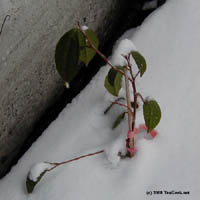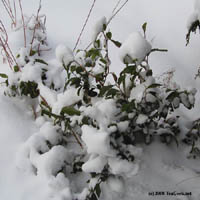Well, official word (in the form of plane and hotel reservations) came in a few days ago that I’m going to the World Tea Expo in Las Vegas this weekend. Actually, I leave tomorrow. If you’re there, I’ll be in booth 525. If I can, I’ll post comments and so forth from there. If not, you won’t see another post until probably mid-May after I come back and have a chance to catch up with stuff. In the mean time, enjoy some tea!
Author: Michael J. Coffey
Teabagging and The Boston Tea Party
Originally, I had been planning on writing a series of posts about the Boston Tea Party to launch on the anniversary of the event this December. However, some folks I don’t much agree with in politics have launched an anti-tax campaign today that begged for a response. Since I could tie it in with tea, well, why not?
The basic idea of their protest is that they will send teabags to their elected representatives if the representative doesn’t change tax policy in a way they’d like. They are calling this act of protest teabagging. Now, it seems they are unaware that this is a slang term for a particular sexual practice (FYI: this link goes to the Wikipedia article defining the behavior in question).
To make the strangeness of the whole supposedly grassroots “movement” (urged on by folks at FOX News) even greater, one of the leaders of this movement was involved in a sex scandal not too long ago. And, it is being promoted most by the sort of ultraconservative folks who might be likely to protest the very behavior that might be confused with the name of the protest they’re promoting. All very odd, and (in my opinion) handled perfectly in this humorous, if slanted, MSNBC story .
The weirdest thing, however, is what is being protested and the imagery they’re using to do it. It’s a protest, on April 15th, of US tax policy. Apparently, tea was chosen as the medium to evoke images of the Boston Tea Party (and not, one supposes, sexual activity). However, even though it’s one of the big events that everyone who goes through public school, most people don’t really have an accurate idea of what really went on then. That’s what this series is going to be about.
No Taxation Without Representation
If you ask most people about the Boston Tea Party, after they talk about the iconic image of colonists dressed as Mohawks throwing tea off the ship, the next thing they’re likely to say is “no taxation without representation.” But what does that actually mean? The issue wasnt, as is commonly thought, that the colonists were annoyed that they didn’t have a say in Parliament back in England. It was actually more nuanced than that.
In the minutes of the “Council of Boston” of November 29th, 1773, a unanimous acceptance of a committee report read, in part:
Previous to the consideration of the petition before the Board, they would make a few observations occasioned by the subject of it. The situation of things between Great Britain and the Colonies has been for some years past very unhappy. Parliament, on the one hand, has been taxing the Colonies, and they, on the other hand, have been petitioning and remonstrating against it, apprehending they have constitutionally an exclusive right of taxing themselves, and that without such a right, their condition would be but little better than slavery.” (Source–Tea Leaves: Being a Collection of Letters and Documents Relating to the Shipment of Tea to the American Colonies in the Year 1773, by the East India Tea Company. 1884. A. O. Crane)
The question, then, wasn’t whether or not the colonists had a voice in London’s Parliament, but rather that they had a conflict with the constitutionality of the tax. The colonists believed, under their colonies’ charters, that it was their exclusive right to tax themselves. They had political structures in place for making these kinds of decisions, and had been using this system for years. The tax in question, imposed from London, applied exclusively to the American colonies–no other location across the British empire had to pay it, thus it seemed to fall within the power of the colonial deliberative assemblies.
The imposition of a tax from London undermined the idea that their political system had any power at all.  In a letter from Thomas Warton of Philadelphia to Thomas Walpole of London on 30 October, 1773, the danger was stated this way:
I may say with great truth, that I do not believe one man in a hundred was to be met with who approved of the sending the tea, while the duty was to be paid here. Yet a great number of people acknowledged the right of the East India Directors to export their teas to America, and declared that nothing less than a confirmed belief that the admitting this mode of taxation would render the assemblies of the people mere cyphers [meaning “a person or thing of no importance”], could have induced them to proceed in the manner they have done…
(In addition to the issue of the tax rendering “the assemblies of the people mere cyphers,” they felt that an easy solution would be had by opposing the tax. The Act of Parliament prevented the East India Company from unloading the ships until the tax was paid, and the directors of the company knew that the American colonists were boycotting (and/or smuggling) tea. The colonists assumed, therefore, that the directors wouldn’t send any tea until the tax issue was resolved. When the company did send the tea after all, the colonists had to come up with other means to prevent the gutting of their political system. More on those attempts in later parts of this series.)
Although “no taxation without representation” is a catchy slogan even after almost 236 years, it would have been more accurate to say something like “no taxation from political bodies without the proper constitutional jurisdiction.” In modern times, it would be something like if the US Congress were to pass a law requiring reisdents of Seattle, and only Seattle, to pay a city-level tax directly to the Federal government, every time they bought a cup of coffee. It’d seem just plain weird, and you wouldn’t really blame the city council from getting a little uppity about it.
That’s basically what happened in Boston, Philadelphia, New York, and other major cities throughout the colonies.
And to conclude this part while pulling it back to today’s protests, it does seem plain weird to use a situation where elected officials were having their power undermined from an “outside” power as the symbol for protesting how duly elected officals are representing their constituents. But that’s just me.
I think you should get involved, though:Â buy some good tea, invite some friends over to drink it with you, and discuss real political issues.
Tea(ish) Book Recommendation: Three Cups of Tea
It’s been a couple of weeks since I finished reading Greg Mortinson’s book, Three Cups of Tea. While the book isn’t really about tea (it’s about the author’s quest to build schools in rural areas of central Asia), the title does come from a concept that most tea people can get behind. It is that the first cup of tea you share is an introduction. The second cup is for friendship. After the third cup, you’re family.
It is an inspiring book, and even if you don’t read the book, you can support education (especially for girls) in these unbelievably remote regions simply by going to the website for the book, where there is a page linking to both Amazon.com and Indiebound.org. Clicking on either and then purchasing a book will result in a portion of your purchase going towards building more schools.
Though it’s not specifically about tea in a Tea Geek kind of way, how can I not give a plug for a guy who does business over tea (and his business has a real chance of bringing about more stability and peace in a sometimes very violent area of the world), and who supports education?
More Reasons to Buy GOOD Tea
As you may know, tea contains theanine, an amino acid found almost exclusively in tea. It is made up of two “mirror” molecules (enantiomers). L-theanine has been associated with all kinds of good stuff like relaxing the mind, lowering blood pressure, and some anti-tumor effects. D-theanine has not. According to Tea: Bioactivity and Therapeutic Potential edited by Yong-su Zhen, D-theanine is usually only on average 1.85% of the total theanine content in tea, but storage at warmer temperatures leaves seem to increase this ratio, and that the “…relative amounts of D-theanine display inverse correlation to tea quality.” The higher quality tea, then, the less D-theanine, which means more L-theanine, which is the one that has the good health benefits.
The book also mentions some interesting information about caffeine in the same section. They cite a source showing a difference between teabag tea and loose leaf tea, as well as steeping time. At 2 minutes of steeping, a cup of teabag tea had about 48 mg of caffeine and loose leaf had about 38 mg. At 5 minutes the teabag was at 80 mg while the loose leaf was 60 mg.
So drink high-quality tea from a place that avoids storage at warmer temperatures, as it seems to be more healthful. And if you’re concerned about caffeine intake, drink loose leaf tea brewed quickly (as is done in Chinese gongfu tea preparation).
I’m a Proud Father of Two
Well, it was bound to happen sooner or later. I spread my seed and the result is the miracle of new life!
The seed was, of course, that which I had painstakingly gathered from the formerly hornet-infested of my two tea plants and documented in an earlier post. Once the seed pods had popped open, I put them in water for a bit and discarded the floaters–I understand they rarely sprout, and if they do, the plants are typically weak and runty. (I kind of like that word: runty)
Anyway, I gathered up the six “sinkers” and poked them down into a well wetted half-sand, half-potting mix concoction that I’d put in the bottom of a gallon-sized plastic zip seal bag. I sealed up the bag and left it on the sill of one of our sunny south-facing windows.
Frankly, I expected to be disappointed. After all, I tried to root cuttings of my favorite rose bush (it was here when we bought the house) and 100% of them dried out or rotted. And I had at least twice as many chances with that one. And the plant is more suited to this climate. So I figured the seeds were gonners. I gave ’em up for dead.
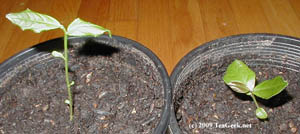 But a couple of days ago, my partner yelled “Hey, you’ve got to look at your tea plants!” I thought to myself, “Oh great, what now? Hornets again?” But when I went to look, I saw he wasn’t pointing outside at the plants I knew about. Instead, he was pointing at the “nursery” bag. There were two shoots, unmistakably something from the Camellia genus. (I bet he didn’t think he’d also be a proud father either…) A 33% germination rate was more than I could have hoped for.
But a couple of days ago, my partner yelled “Hey, you’ve got to look at your tea plants!” I thought to myself, “Oh great, what now? Hornets again?” But when I went to look, I saw he wasn’t pointing outside at the plants I knew about. Instead, he was pointing at the “nursery” bag. There were two shoots, unmistakably something from the Camellia genus. (I bet he didn’t think he’d also be a proud father either…) A 33% germination rate was more than I could have hoped for.
Well, I was overjoyed. I think I danced around like a crazy man for a few minutes. Or maybe more. If I smoked, I would have given out cigars. But I don’t, so I celebrated by boiling up some of the cousins of my new babies and had a nice cuppa instead. (Ew. I know, it didn’t occur to me until later how macabre that was…)
Anyway, I’ve just finished moving the “boys” out of the nursery and into their new rooms. I think they’re big enough that they shouldn’t be sharing the same bag any more.
Stay tuned for more on the little rascals as they grow up.
Oh, and to underscore the geeky part of “Tea Geek,” I’ll end with an excerpt from the lyrics of the best song ever written for the end of a video game:
“This was a triumph.
I’m making a note here:
HUGE SUCCESS.
It’s hard to overstate
my satisfaction.”
An Insider’s Secret for Finding Affordable Tea
It’s been a while since I last posted, but I’ve known what I was going to post for weeks. (I’ve been getting ready for the experimental Online Tea Tasting–if it works out well, keep an eye on the “Tea Geek Events” section at https://teageek.net/store/ ).
With the economy seeming to get worse every week, most people are looking for ways to economize. But with tea there’s a “secret” I’ve learned during my years in the tea business that will no doubt seem very counter-intuitive. However, I want to share it with you so that you can make better choices when buying tea.
You’re usually better off buying more expensive tea.
Here’s why: Every tea business I’ve been involved with (including a wholesaler and two retailers, plus Tea Geek) does the same thing when it comes to marking up tea. They have a selection of teas that are affordable and make up a healthy percentage of what people buy; they also have a selection of higher-end teas that meet with a good deal of resistance on the part of customers. (Customers like inexpensive tea.)
However, generally speaking, it’s the higher-end teas that have the lowest markup. That means that a higher percentage of your spending goes to good tea and not to the decor of the shop or the landlord or into the pockets of the owners. (Not that you shouldn’t support tea shop owners–you should. They still make money even on the expensive ones; if they don’t, they’re not very good at running a business.)
Here’s an example: Say you’re interested in two teas.  The first tea costs $2.50 per ounce, while the second tea costs $5.00 per ounce.  You might naturally think that the $2.50 is a better deal–and it is, if you don’t consider what you actually get for that money.
Based on what I’ve seen in the industry, I might guess that the ounce of $2.50 tea cost the shop $0.50 or $0.75. Some teas are even marked up 700-800%…meaning your ounce of tea might really be only $0.30 worth of tea to the wholesaler the shop bought it from.
On the other hand, the $5.00 ounce of tea may be marked up less than 100%. You might get it for only an 80% markup. This ounce of tea might be worth $2.75 to the wholesaler.
Now compare those. By paying twice as much for an ounce of tea ($5.00 compared to $2.50), you’re really getting nine times the tea–not in weight, but in value ($2.75 vs. $0.30).
Granted, this is a hypothetical example and any specific situation is certain to be different in some aspect. But the general rule seems to apply–more expensive teas have lower markup, and thus are a better buy when you consider what you get for your money.
(I should also note that I’m assuming you’re getting bulk loose tea. Fancy packaging usually costs more than the tea it’s in, so assume an even higher markup if the tea is in some kind of exotic-looking box with high production values, or is in tea bags, etc. It’s all stuff that encourages people to buy, but you don’t end up drinking the box–you drink the tea.)
Tea is an affordable luxury, and buying bulk loose high-end tea is usually a better proposition than cheaper tea, or expensive tea that’s been packaged.
Not Good Tea Weather: Seattle, December 2008
Tea Nomenclature: The Confusion
When we talk about a particular tea–Darjeeling, for example, or Bai Hao Wulong–it’s something of an error to think of it as “a” tea. Really, all of these names, from Dragonwell to Silver Needles to Puer to Assam, are all categories of tea. To be truly speaking of a single pure (i.e. non-blended) tea, you need to talk about a particular batch, picked on the same day, and following it straight through processing at a single facility without getting mixed in with any other batch. Even from the same farm and the same plants, and the same processing style, each picking (even if two pickings happen from the same patch of plants on the same day) will be different. A tea picked early in the morning will often produce a lower-quality tea than leaves picked just before noon, so a tea farmer sometimes produces two different teas in a single day.
But with each farm potentially making potentially two different teas each day the weather’s good, how do you differentiate? How do you refer to one versus another? Well, that’s where it gets even more confusing. As with all things in the tea world, the right answer appears to be “it depends.”
Generally, a tea can be referred to by a number of different features of its production history. It can be referred to by geography, whether a city (Darjeeling, Puer) or a state/province/region (Assam, Yunnan, Keemun/Qimen), or a local feature (Dragon Well, Alishan [Mt. A-Li]). Other teas are referred to primarily by what varietal of the tea plant they are made from: Tie Guan Yin (Iron GuanYin), Jin Xuan (Golden Lily), Si Ji Chun (Four Season Spring). Still others are named based on their appearance: Bi Luo Chun (Green Spiral Spring), Yin Zhen (Silver Needle). Some just have fanciful names like Oriental Beauty or Old Work Tea. And to make matters worse, some are named after a combination, as in “Wuyi” which is both a mountain range and the name of a varietal, and often implies a certain style of processing. And “Oolong” or “Wulong” (same Chinese characters, different method of rendering into English letters) can refer either to the entire category of semi-oxidized teas or to a specific cultivar of Camellia sinensis var. sinensis or even to the specific semi-oxidized teas made from that cultivar.
Then there are the modifications to this basic name. Some teas are classified by the British system, dividing teas into grade based on how big the leaf pieces are. The bigger the pieces, the higher the grade. These grade divisions are encoded in a string of letters such as BOPF (Broken Orange Pekoe Fannings, otherwise known as “very small pieces”) and FTGFOP (Finest Tippy Golden Flowery Orange Pekoe, or sometimes jokingly translated as “Far Too Good For Ordinary People”). Other teas are graded by how much effort and care has gone into them. Keemun Congou–or “Qimen Gongfu” if you de-Anglicise it–is the basic quick and dirty version, while Keemun Mao Feng has more care taken but still uses somewhat older leaves, and Keemun Hao Ya takes the most effort and uses the most young and delicate leaves. Hao Ya is divided further into “A” and “B” with the former being the cream of the crop. Keemun Hao Ya “A” goes through an extra hand-sorting process that is skipped with “B”.
Then, going from the frying pan into the fire as they say, some teas are named incorrectly. That is to say, there are many teas called “Dong Ding” that are not made actually on Dong Ding mountain. They’re called that because they’re made in the style of teas from that area. Another is Chinese Sencha. Sencha is a distinctly Japanese tea, but for economic and business reasons, some Japanese tea companies are having the tea grown in China but processed like they would have been had it been grown in Japan. Is this really Sencha, or a Chinese green tea made in the Sencha tradition to Japanese specifications?
All of this boils down to an impossibly complicated and confusing mess when it comes to referring to a particular tea. To be really accurate, one could refer to all of the specifics, like “Makaibari Estate, Darjeeling, India, FTGFOP, Black Tea, Pick Date May 2nd, 2008, 10:45am” or “Su family farm, Dong Ding Shan, Nantou County, Taiwan, oxidized for 12 hours at an average of 20 degrees Celsius, rolled mechanically, and roasted three times for 2 hours each at 80, 100, and 110 degrees. Only picking of November 12th 2008, from the lower of the two patches of Wulong varietal.”
But who wants to ask for a cup of that?
However, what might help is if everyone starts asking about these aspects of nomenclature. Ask at your local tea shop if they know whether this wulong was hand picked and processed or machine harvested. Ask your waiter at the restaurant if the Darjeeling is a blend or single estate. Check your online tea sources for varietal of tea plant used.
While the tea industry is nowhere near agreeing on a universal nomenclature to describe each tea one from another, at least by asking the questions to clarify these finer points we can all encourage tea industry professionals to know their stuff. And even if it’s called “Li Shan Wulong” on the jar or package, you may be able to discover information that differentiates this one from the “Li Shan Wulong” from the shop down the street. At least then we as a tea community can start talking about teas with real information and not just the short label of two or three words given to the true complexities of geography, climate, botany, biochemistry, and human artistry that make each and every batch of tea unique.
Preparation for the Pinglin Baozhong Competition
One of the experiences I had in Taiwan was to visit Pinglin, where a famous tea competition is held at least twice each year–for the Spring and Winter tea seasons. Pinglin is a township in Taipei County, a little more east than south of the city of Taipei in northern Taiwan. On the one hand, it was disappointing because we got there when the weather was awful for tea picking and processing. On the other, we got there on the first day that farmers were bringing in their entries for the Winter competition.
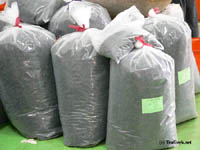 It was an interesting process to see, with lots of people working very fast. First, the farmer would arrive at the school gymnasium with a large sack of tea weighing about 28 pounds (or just over 12.6 kilos). The sack would be weighed, and a number would be assigned. Forty-two metalic bags and a small plastic zip-close bag would be put into the farmer’s sack. All 43 inserted bags would have already been labeled in advance with the assigned number by the industrious people at the first table. A person further down the table would take some of the tea and put it in the zip-close bag and set it aside.
It was an interesting process to see, with lots of people working very fast. First, the farmer would arrive at the school gymnasium with a large sack of tea weighing about 28 pounds (or just over 12.6 kilos). The sack would be weighed, and a number would be assigned. Forty-two metalic bags and a small plastic zip-close bag would be put into the farmer’s sack. All 43 inserted bags would have already been labeled in advance with the assigned number by the industrious people at the first table. A person further down the table would take some of the tea and put it in the zip-close bag and set it aside.
 Next, the big sack was taken to one of five tables scattered around one side of the gym. Each table was covered in plastic and was attended by six or seven people, mostly women with generally a man supervising or auditing. The 42 metallic bags are taken out and the tea is dumped on the plastic-covered table. Each of the metallic bags holds half a jin of tea. (A jin in Taiwan is 600 grams, which is slightly more than either 21 ounces, or 1.3 pounds. To be confusing, in mainland China, a jin is 500 grams, or about 1.1 pounds.) Most of the people at the table scoop up roughly a half-jin of tea and put it in one of the bags. They are then given to a person with a scale who fine-tunes the weight to exactly 300 grams per bag. The bags then go to yet another person who heat-seals each bag and packs them into two boxes labeled with the appropriate lot number. Ten jin (20 bags) fit in each box, for a total of 20 jin. The other two bags don’t fit into the boxes.
Next, the big sack was taken to one of five tables scattered around one side of the gym. Each table was covered in plastic and was attended by six or seven people, mostly women with generally a man supervising or auditing. The 42 metallic bags are taken out and the tea is dumped on the plastic-covered table. Each of the metallic bags holds half a jin of tea. (A jin in Taiwan is 600 grams, which is slightly more than either 21 ounces, or 1.3 pounds. To be confusing, in mainland China, a jin is 500 grams, or about 1.1 pounds.) Most of the people at the table scoop up roughly a half-jin of tea and put it in one of the bags. They are then given to a person with a scale who fine-tunes the weight to exactly 300 grams per bag. The bags then go to yet another person who heat-seals each bag and packs them into two boxes labeled with the appropriate lot number. Ten jin (20 bags) fit in each box, for a total of 20 jin. The other two bags don’t fit into the boxes.
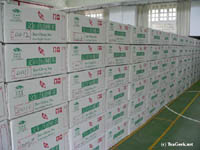 Ah, but there’s a method to this madness. The two boxes are then stacked in the half of the gym where nobody is working. (Over the course of the 5 days when entries can be delivered, that half of the gym will be more or less filled with tea. Next time you’re in a gym, think of half of it filled with tea leaves and consider how much space the ounce or two you typically buy at your local tea shop takes up. It’s a staggering amount of tea.)  The two forlorn bags that didn’t fit into the neatly stacked boxes are eventually taken to the building where the judging happens. This last “extra” jin is what gets brewed for the judges. Any tea left from the original farmer’s sack is put back in and given back to him. Even though it’s from the same batch, it cannot legally be called competition tea because it’s not in the special numbered bags.
Ah, but there’s a method to this madness. The two boxes are then stacked in the half of the gym where nobody is working. (Over the course of the 5 days when entries can be delivered, that half of the gym will be more or less filled with tea. Next time you’re in a gym, think of half of it filled with tea leaves and consider how much space the ounce or two you typically buy at your local tea shop takes up. It’s a staggering amount of tea.)  The two forlorn bags that didn’t fit into the neatly stacked boxes are eventually taken to the building where the judging happens. This last “extra” jin is what gets brewed for the judges. Any tea left from the original farmer’s sack is put back in and given back to him. Even though it’s from the same batch, it cannot legally be called competition tea because it’s not in the special numbered bags.
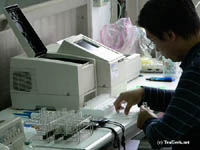 Meanwhile, that little zip-close baggie of tea that was separated at the beginning of this process is taken to the ground floor of the building where, upstairs, the judging will occur. Below, however, are a couple of people hard at work brewing samples of tea. They, however, don’t get to drink it. Instead, they put the tea in fancy scientific equipment to test the samples for pesticides and agricultural chemicals (which was something that took a while for me to figure out–I didn’t know the Chinese term for “pesticides and agricultural chemicals” and the closest our friend Mr. Tsai knew in English was “medicine.” Thank goodness for Pleco!)
Meanwhile, that little zip-close baggie of tea that was separated at the beginning of this process is taken to the ground floor of the building where, upstairs, the judging will occur. Below, however, are a couple of people hard at work brewing samples of tea. They, however, don’t get to drink it. Instead, they put the tea in fancy scientific equipment to test the samples for pesticides and agricultural chemicals (which was something that took a while for me to figure out–I didn’t know the Chinese term for “pesticides and agricultural chemicals” and the closest our friend Mr. Tsai knew in English was “medicine.” Thank goodness for Pleco!)
Since we were there on the 12th of November and the actual judging didn’t start until, I think, the 20th. If my understanding of the explanation wasn’t too far off and my memory holds, the three days of judging were November 20th through the 22nd, and the winners were announced on the 24th. But Mr. Tsai and Mr. Chen did treat us to a tasting of three submissions (but I don’t know their numbers so I can’t tell if any of them won or not).
My friend and tea teacher, Shiuwen Tai, now has available the First Place, Second Place, an Honorable Mention, and one of her supplying farmer’s personal favorites (“Farmer’s Choice” she calls it). I have some tea made by the Second Place farmer, but it wasn’t the same batch that won. Check out mine at the Tea Geek Store, and Shiuwen’s at FloatingLeaves.com. Get a little of each and taste them side-by-side!
Language and Tea Research
I was just going over some of the materials I picked up on my trip to Taiwan to glean a little something to put on the Tea Geek wiki and I was struck by how important language fluency is to getting good information about tea. I already know that the English-speaking world gets some basic information wrong because of the translation of Chinese word 發酵 (pronounced “fa jiao” according to four dictionaries, but everyone I’ve heard actually say it would be “fa xiao” in pinyin)–in Chinese it can mean either “ferment” or “oxidize” and is often translated one way when the other is more accurate. Thus, we get black tea being called “fully fermented” when it isn’t fermented at all.
But then there are translations that just are bewildering. This is the description, in English, that I found about how Baozhong tea is made: “The tea-making process requires the undertaking of tea soot picking collection, shrinkage and fall by sunlight, indoor shrinkage and stir mix, tea cream stir-fry, kneading, and dessication in order to complete the strip-shaped Paochung Tea characteristic of Pinglin.”
Now, I’ve seen wulong production and I generally understand what steps they’re talking about but I’m confused why some of those English words show up in that description. For example, “tea cream stir-fry”? That sounds like a weird entree or something. Imagine that your local tea shop sees that description of the process of making this tea and doesn’t have any recourse to either (a) someone who has seen the process, or (b) knows a Chinese speaker or knows a little Chinese themselves.  What stories do you suppose they’d tell their customers and/or other folks in the tea industry to show off what they know about tea?
(By the way, the “tea cream stir-fry” process is, I think, the “kill green” process where heat is applied for a few minutes to stop oxidation in the leaf; this pamphlet didn’t include the Chinese characters to double-check. Some teas like Longjing/Dragonwell have “kill green” done by hand in an actual wok much like stir-fry. Other teas are made using what looks like a very deep industrial clothes drier. As to the “tea soot picking collection,” I think they mean “tea shoot picking collection” rather than some process where ashes are spread over the fields or something… although there does seem to be a craze where bamboo-charcoal is being added to all kinds of things as a cure-all. Not sure how much science there is behind it, though some of the claims I saw were at least possible.)
